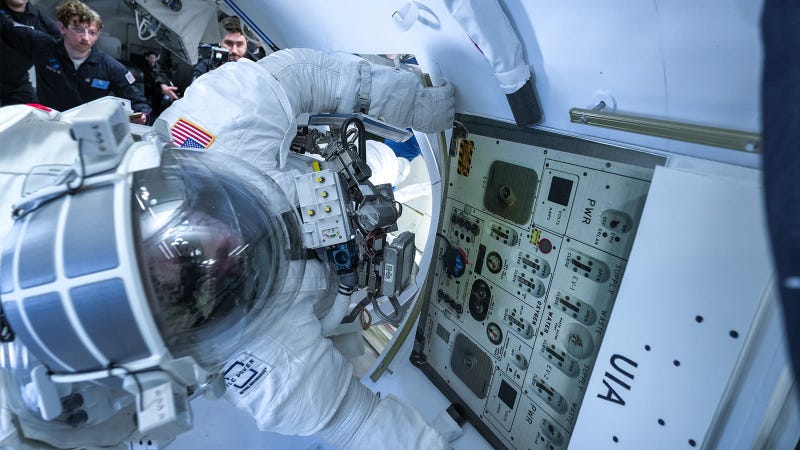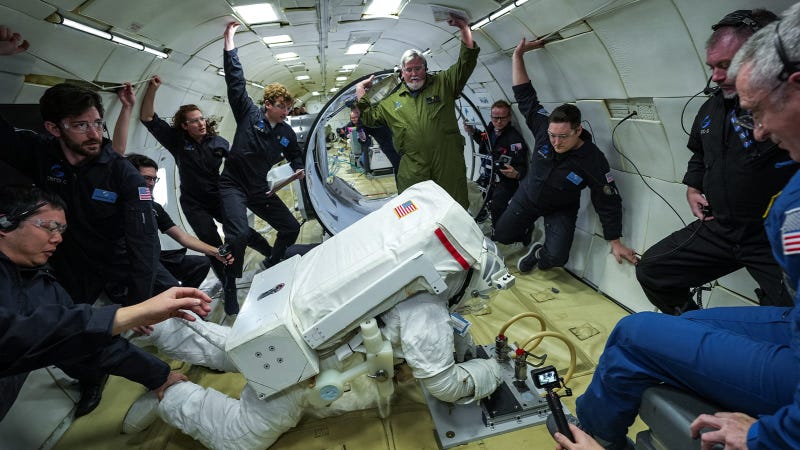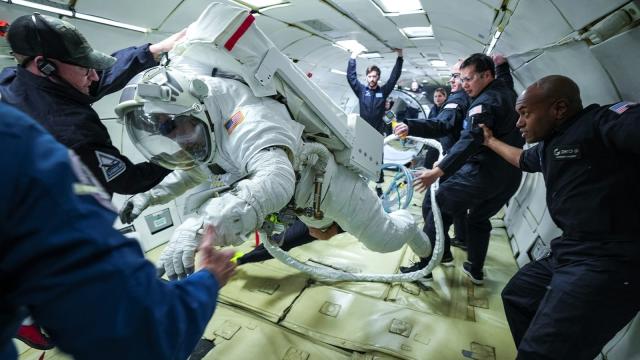NASA’s current batch of ISS spacesuits are getting long in the tooth, having been in service for over four decades. The space agency is keen to acquire spacesuits fit for the 21st century, and recent zero-gravity tests performed by Collins Aerospace are a step in the right direction.
North Carolina-based Collins Aerospace, in partnership with ILC Dover and Oceaneering, completed a key milestone in the development of a new generation spacesuit meant for use aboard the International Space Station. This progress comes under NASA’s Exploration Extravehicular Activity Services (xEVAS) contract, valued at $US97.2 million and awarded to Collins in December 2022.
This important step, known as the Crew Capability Assessment test, involved the suit’s use in a simulated space environment on Earth. Or more specifically, in an aircraft flying above Earth. With this goal now met, NASA can extend the contract for a spacesuit demonstration to be conducted outside the ISS by April 2026. During this demonstration, crew members will don the spacesuit outside the orbital lab.

The updated suits are woefully overdue. The pressing need stems from the challenges posed by NASA’s current Extravehicular Mobility Units (EMUs), which have been in use for over 40 years. Issues such as water leakage, size and fit limitations, and aging technology highlight the urgency for upgraded spacesuits. And the current EMUs are increasingly difficult to maintain, inflexible, and have limited mobility, making them unsuitable for future lunar and Mars missions.
Take, for example, the 2013 incident involving astronaut Luca Parmitano, who experienced helmet flooding, highlighting the critical need for improvements. In 2022, ESA astronaut Matthias Maurer noticed some water and dampness on his visor during a spacewalk, an incident that led NASA to temporarily suspend EVAs pending an investigation.
Collins Aerospace, an RTX business, is seeking to address these challenges with its next-generation suit, which boasts features like lighter weight and lower volume compared to current NASA suits, as well as an open architecture design for easy modifications. Its team collaborated with current and former astronauts to build a suit that meets the diverse needs of space explorers.

The recent test to assess the new suit’s functionality happened aboard a zero gravity aircraft, in simulated microgravity conditions. As SpaceflightNow reports, former NASA astronauts John “Danny” Olivas and Dan Burbank, along with a support team, experienced 40 parabolas of weightlessness during the flight to evaluate the suit’s pressure garment system, functionality with ISS tools and interfaces, and performance against the current EMU design.
“The test allowed us to examine specific objectives of the design that can support a broad range of crewmember sizes and crew tasks in a controlled environment,” Peggy Guirgis, general manager of space Systems at Collins, said in a press release.
Before the critical design review, Collins plans additional evaluations, including an underwater test at NASA’s Neutral Buoyancy Lab in Texas and a thermal vacuum test. These tests are crucial in ensuring the suit’s functionality in various space-like conditions.
Collins’s efforts are part of a broader initiative to advance space exploration. In July 2023, the company received an additional $US5 million as part of its xEVAS contract to develop a specialised EVA suit for lunar surface missions under NASA’s Artemis program. The company says its spacesuit is nearly 90 per cent compatible with lunar missions. At the same time, Axiom Space, based in Houston, is currently laser-focused on the Moon suits that will be used for NASA’s upcoming Artemis 3 mission to the lunar surface.
